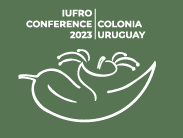Differential photosynthetic response to short- and long-term water deficit in Eucalyptus clones and hybrids with red gums
DOI:
https://doi.org/10.31285/AGRO.27.1266Palabras clave:
drought, water use efficiency, gas exchangeResumen
In Uruguay, there are more than a million hectares forested, and Eucalyptus species predominate. Drought events are becoming more frequent and affecting growth of the stands, especially during the early stages of the crop. Thus, the need arises to analyze the effects of such events on processes that determine growth, such as photosynthesis. The effect of water restriction on photosynthetic parameters was analyzed under greenhouse conditions in 6-months-old rooted cuttings of a clone of E. grandis (GG) and two hybrids with red gums: E. grandis × E. camaldulensis (GC) and E. grandis × E. tereticornis (GT). To define irrigation regimes water potential of substrate (MPa) was assessed using samples with increasing water content (%HR, w|w). Data was used to fit a water retention curve. Field’s capacity pot weight was determined on water drained pots. The control condition (WW) was established at Ψw = -0.15 MPa, while the water restricted (WR) was Ψw = -0.30 MPa. Treatments were maintained by manually water feeding for 16 weeks. Physiological parameters and photosynthetic pigments were recorded 6 and 16 weeks after water withholding to simulate short- and long-term water restriction scenarios, respectively. The following measurements were registered on current year fully expanded sun-exposed leaves: stomatal conductance (gs), maximum net assimilation rate (Amax), PSII quantum efficiency (FPSII), and proportion of chlorophyll and carotenoids in a HPLC elution (%Chl, %Carot). In the initial period, GG maintained Amax and gs between conditions. However, despite exhibiting lower gs in the restricted condition, GC maintained their Amax and GT increased in WR. There was no effect of treatment on photosynthetic pigments and energy partitioning varied little. At the end of the 16-week period, GG showed only decreased stomatal conductance values, and did not change photosynthetic pigment content nor Amax despite water restriction. Hybrids showed increasing values of FPSII, %Chl, and Amax. The PCA for long-term water restriction data showed that pigment content and FPSII may explain the increased assimilation rate of the hybrid clones under WR. Changes in water use efficiency due to higher % Chl in the restricted condition for both hybrids are discussed. There are few reports of increments in chlorophyll in Eucalyptus in drought. Recent information suggests that these types of strategies are adaptative responses that allow plants to cope with stress.
Descargas

Descargas
Publicado
Cómo citar
Número
Sección
Licencia
Derechos de autor 2023 Agrociencia Uruguay

Esta obra está bajo una licencia internacional Creative Commons Atribución 4.0.
| Estadísticas de artículo | |
|---|---|
| Vistas de resúmenes | |
| Vistas de PDF | |
| Descargas de PDF | |
| Vistas de HTML | |
| Otras vistas | |















